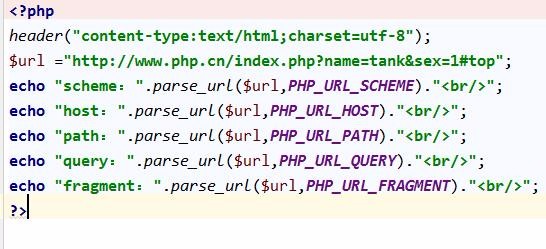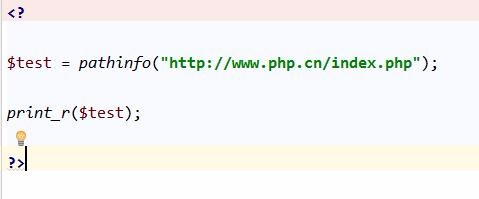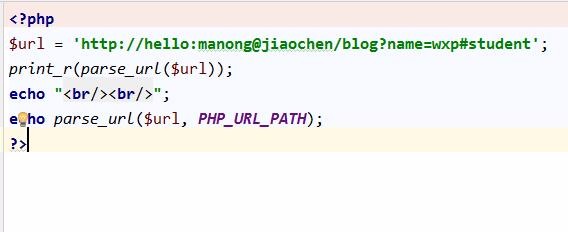10 recommended courses about parse_url()
There are two functions for parsing URLs in PHP, namely the parse_str() function and the parse_url() function. The parse_str function parses the query string into a variable, and the parse_url function is used to parse the entire URL and return its components. Part, the previous article also explained these two functions respectively. This article mainly introduces the usage and difference between the two functions of php parse_str() function and parse_url() function when parsing URLs. First look at the php parse_str function. The php parse_str function parses the query string into variables. The parse_str function has two parameters. The first parameter is the query string that needs to be parsed and is required. The second parameter is used to set the variable that receives the parsed query string. The second parameter is optional. Please see the following example: Here we use parse_url to obtain the query string of the URL. The parse_url function is explained below.
1. Detailed introduction to parse_str()

##Introduction: There are two functions for parsing URLs in PHP, namely the parse_str() function and the parse_url() function. The parse_str function parses the query string into a variable, parse_url The function is used to parse the entire URL and return its components. The previous article also explained these two functions respectively. This article mainly introduces the php parse_str() function and parse_url() function when parsing the URL. usage and differences. First look at php par...
##2.php parse_url() function summary of URL usage

3.
The difference between the php parse_str() function and the parse_url() function to parse URLs

4.
Explanation on using php pathinfo(), parse_url(), basename() functions to parse URLs

5.
Detailed explanation of php parse_url () function definition and usage
 ##Introduction: What is the role of the php parse_url() function? The parse_url() function in php parses the URL and returns the components of the URL. Its syntax is as follows:
##Introduction: What is the role of the php parse_url() function? The parse_url() function in php parses the URL and returns the components of the URL. Its syntax is as follows:
6.
php uses the functions pathinfo(), parse_url() and basename() to parse the URL_php instanceIntroduction: As we all know, the functions pathinfo(), parse_url() and basename() in PHP are all functions for parsing URLs, but there are some differences. Here are some examples, which are easier to understand through examples. Friends in need can refer to the usage methods and techniques of these three functions. Friends who are interested can learn together below.
7. The implementation code of using parse_url to parse the URL in php Detailed explanation of parse_url
Introduction:: Using parse_url in php to parse the URL Detailed explanation of the implementation code of parse_url: PHP parsing URL function: parse_url Detailed explanation parse_url - parses the URL and returns its component description array parse_url (string $url) This function parses a URL and returns an associative array, containing various components that appear in the URL part. This function is not used to verify the validity of the given URL, only to break it into the parts listed below. Incomplete URLs are also accepted, and parse_url() will try to be as correct as possible
8. Detailed explanation of PHP functions: parse_url()
Introduction: Detailed explanation of PHP function: parse_url()
Introduction: Implementation code for using parse_url() in PHP to parse URLs (detailed explanation of parse_url). PHP parsing URL function: parse_url detailed explanation parse_url - parses the URL and returns an array of descriptions of its components parse_url (string $url) This function parses a URL and returns an associative array,
10. Introduction to the usage of the parse_url() function in php
Introduction: Introduction to the usage of the parse_url() function in php. This article introduces the usage of parse_url() function in PHP. Friends who need to use parse_url() function can refer to this article. A useful function parse_url in PHP, especially convenient
The above is the detailed content of 10 recommended courses about parse_url(). For more information, please follow other related articles on the PHP Chinese website!

Hot AI Tools

Undresser.AI Undress
AI-powered app for creating realistic nude photos

AI Clothes Remover
Online AI tool for removing clothes from photos.

Undress AI Tool
Undress images for free

Clothoff.io
AI clothes remover

Video Face Swap
Swap faces in any video effortlessly with our completely free AI face swap tool!

Hot Article

Hot Tools

Notepad++7.3.1
Easy-to-use and free code editor

SublimeText3 Chinese version
Chinese version, very easy to use

Zend Studio 13.0.1
Powerful PHP integrated development environment

Dreamweaver CS6
Visual web development tools

SublimeText3 Mac version
God-level code editing software (SublimeText3)

Hot Topics
 Alipay PHP SDK transfer error: How to solve the problem of 'Cannot declare class SignData'?
Apr 01, 2025 am 07:21 AM
Alipay PHP SDK transfer error: How to solve the problem of 'Cannot declare class SignData'?
Apr 01, 2025 am 07:21 AM
Alipay PHP...
 Explain JSON Web Tokens (JWT) and their use case in PHP APIs.
Apr 05, 2025 am 12:04 AM
Explain JSON Web Tokens (JWT) and their use case in PHP APIs.
Apr 05, 2025 am 12:04 AM
JWT is an open standard based on JSON, used to securely transmit information between parties, mainly for identity authentication and information exchange. 1. JWT consists of three parts: Header, Payload and Signature. 2. The working principle of JWT includes three steps: generating JWT, verifying JWT and parsing Payload. 3. When using JWT for authentication in PHP, JWT can be generated and verified, and user role and permission information can be included in advanced usage. 4. Common errors include signature verification failure, token expiration, and payload oversized. Debugging skills include using debugging tools and logging. 5. Performance optimization and best practices include using appropriate signature algorithms, setting validity periods reasonably,
 How does session hijacking work and how can you mitigate it in PHP?
Apr 06, 2025 am 12:02 AM
How does session hijacking work and how can you mitigate it in PHP?
Apr 06, 2025 am 12:02 AM
Session hijacking can be achieved through the following steps: 1. Obtain the session ID, 2. Use the session ID, 3. Keep the session active. The methods to prevent session hijacking in PHP include: 1. Use the session_regenerate_id() function to regenerate the session ID, 2. Store session data through the database, 3. Ensure that all session data is transmitted through HTTPS.
 How to debug CLI mode in PHPStorm?
Apr 01, 2025 pm 02:57 PM
How to debug CLI mode in PHPStorm?
Apr 01, 2025 pm 02:57 PM
How to debug CLI mode in PHPStorm? When developing with PHPStorm, sometimes we need to debug PHP in command line interface (CLI) mode...
 Describe the SOLID principles and how they apply to PHP development.
Apr 03, 2025 am 12:04 AM
Describe the SOLID principles and how they apply to PHP development.
Apr 03, 2025 am 12:04 AM
The application of SOLID principle in PHP development includes: 1. Single responsibility principle (SRP): Each class is responsible for only one function. 2. Open and close principle (OCP): Changes are achieved through extension rather than modification. 3. Lisch's Substitution Principle (LSP): Subclasses can replace base classes without affecting program accuracy. 4. Interface isolation principle (ISP): Use fine-grained interfaces to avoid dependencies and unused methods. 5. Dependency inversion principle (DIP): High and low-level modules rely on abstraction and are implemented through dependency injection.
 How to automatically set permissions of unixsocket after system restart?
Mar 31, 2025 pm 11:54 PM
How to automatically set permissions of unixsocket after system restart?
Mar 31, 2025 pm 11:54 PM
How to automatically set the permissions of unixsocket after the system restarts. Every time the system restarts, we need to execute the following command to modify the permissions of unixsocket: sudo...
 Explain late static binding in PHP (static::).
Apr 03, 2025 am 12:04 AM
Explain late static binding in PHP (static::).
Apr 03, 2025 am 12:04 AM
Static binding (static::) implements late static binding (LSB) in PHP, allowing calling classes to be referenced in static contexts rather than defining classes. 1) The parsing process is performed at runtime, 2) Look up the call class in the inheritance relationship, 3) It may bring performance overhead.
 How to send a POST request containing JSON data using PHP's cURL library?
Apr 01, 2025 pm 03:12 PM
How to send a POST request containing JSON data using PHP's cURL library?
Apr 01, 2025 pm 03:12 PM
Sending JSON data using PHP's cURL library In PHP development, it is often necessary to interact with external APIs. One of the common ways is to use cURL library to send POST�...






